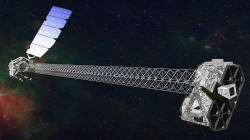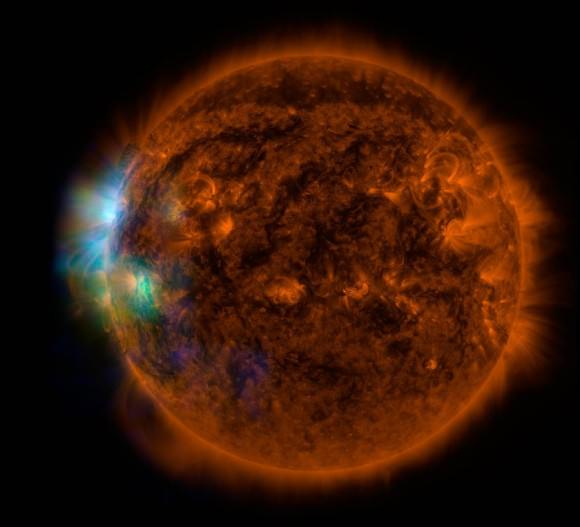What if you had x-ray vision like Superman? Or if those funny-looking glasses they advertised in comic books in the 60s actually worked?* Then with those our Sun might look something like this, lighting up with brilliant flares of high-energy x-rays as seen by NASA’s super-sensitive NuSTAR Space Telescope (with a little help from SDO.)

Of course NASA’s orbiting NuSTAR x-ray telescope is not like a typical medical imaging system. Instead of looking for broken bones, NuSTAR (short for Nuclear Spectroscopic Telescope Array) is made to detect high-energy particles blasting across the Universe from exotic objects like supermassive black holes, pulsars, and supernovae.
Read more: Stars Boil Before They Blow Up, Says NuSTAR
But astronomers suggested turning NuSTAR’s gaze upon our own Sun to see what sorts of x-ray activity may be going on there.
“At first I thought the whole idea was crazy,” said Fiona Harrison, a Professor of Physics and Astronomy at Caltech and PI for the NuSTAR mission. “Why would we have the most sensitive high energy X-ray telescope ever built, designed to peer deep into the universe, look at something in our own back yard?”
As it turns out NuSTAR was able to reveal some very interesting features on the Sun, showing where the corona is being heated to very high temperatures. The image above shows NuSTAR’s first observations, overlaid onto data acquired by NASA’s Solar Dynamics Observatory.
NuSTAR data is shown in green and blue, revealing high-energy emission around – but not exactly aligned with – active regions on the Sun where solar plasma is being heated to more than 3 million degrees. The red represents ultraviolet light captured by SDO and shows material in the solar atmosphere at a slightly cooler 1 million degrees.

Because the Sun isn’t terribly intense in high energy x-ray output it’s safe to observe it with NuSTAR — it’s not likely to burn out the telescope’s sensors. But what NuSTAR can detect may help astronomers determine the exact mechanisms behind the intense coronal heating that occurs in and above the Sun’s chromosphere. If so-called “nanoflares” — miniature and as-yet-invisible versions of solar flares — are responsible, for instance, NuSTAR might be able to catch them in action for the first time.
Read more: Warm Coronal Loops May Hold the Key to Hot Solar Atmosphere
“NuSTAR will be exquisitely sensitive to the faintest X-ray activity happening in the solar atmosphere, and that includes possible nanoflares,” said David Smith, solar physicist and member of the NuSTAR team at the University of California, Santa Cruz.
In addition NuSTAR could potentially detect the presence of axions in the Sun’s core — hypothesized particles that may make up dark matter in the Universe.
NuSTAR may not be a “solar telescope” per se, but that won’t stop astronomers from using its unique abilities to learn more about the star we intimately share space with.
“NuSTAR will give us a unique look at the Sun, from the deepest to the highest parts of its atmosphere.”
– David Smith, solar physicist, University of California Santa Cruz
Read more in a JPL article here.
*I never did get my box of 100 army men, either. Then again, I may have ordered a few decades too late.

